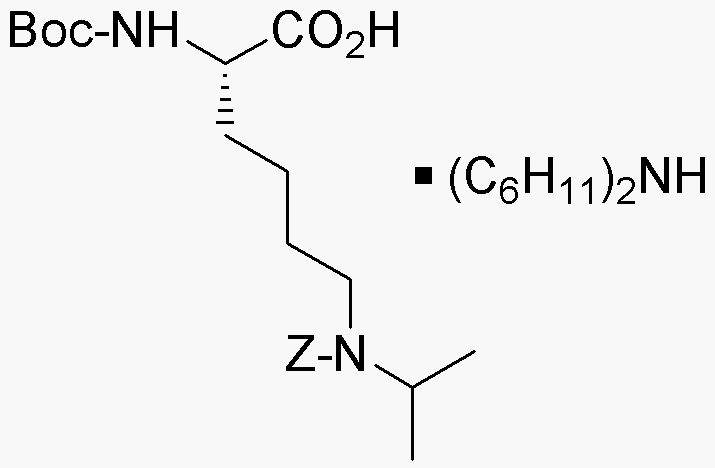Na-Boc-Ne-isopropyl-Ne-Z-L-lysine dicyclohexylammonium salt is widely utilized in research focused on:
- Peptide Synthesis: This compound serves as a valuable building block in the synthesis of peptides, particularly in the pharmaceutical industry where custom peptides are needed for drug development.
- Bioconjugation: It is used in bioconjugation processes, allowing researchers to attach biomolecules to surfaces or other molecules, enhancing the efficacy of drug delivery systems.
- Protein Engineering: The compound plays a role in modifying proteins to improve their stability and functionality, which is crucial in the development of therapeutic proteins and enzymes.
- Research on Drug Delivery: It is applied in studies aimed at optimizing drug delivery mechanisms, particularly in targeted therapies where precision is essential for effectiveness.
- Development of Diagnostic Tools: This chemical is also utilized in the creation of diagnostic agents, aiding in the detection of diseases through improved imaging techniques.
General Information
Properties
Safety and Regulations
Applications
Na-Boc-Ne-isopropyl-Ne-Z-L-lysine dicyclohexylammonium salt is widely utilized in research focused on:
- Peptide Synthesis: This compound serves as a valuable building block in the synthesis of peptides, particularly in the pharmaceutical industry where custom peptides are needed for drug development.
- Bioconjugation: It is used in bioconjugation processes, allowing researchers to attach biomolecules to surfaces or other molecules, enhancing the efficacy of drug delivery systems.
- Protein Engineering: The compound plays a role in modifying proteins to improve their stability and functionality, which is crucial in the development of therapeutic proteins and enzymes.
- Research on Drug Delivery: It is applied in studies aimed at optimizing drug delivery mechanisms, particularly in targeted therapies where precision is essential for effectiveness.
- Development of Diagnostic Tools: This chemical is also utilized in the creation of diagnostic agents, aiding in the detection of diseases through improved imaging techniques.
Documents
Safety Data Sheets (SDS)
The SDS provides comprehensive safety information on handling, storage, and disposal of the product.
Product Specification (PS)
The PS provides a comprehensive breakdown of the product’s properties, including chemical composition, physical state, purity, and storage requirements. It also details acceptable quality ranges and the product's intended applications.
Certificates of Analysis (COA)
Search for Certificates of Analysis (COA) by entering the products Lot Number. Lot and Batch Numbers can be found on a product’s label following the words ‘Lot’ or ‘Batch’.
*Catalog Number
*Lot Number
Certificates Of Origin (COO)
This COO confirms the country where the product was manufactured, and also details the materials and components used in it and whether it is derived from natural, synthetic, or other specific sources. This certificate may be required for customs, trade, and regulatory compliance.
*Catalog Number
*Lot Number
Safety Data Sheets (SDS)
The SDS provides comprehensive safety information on handling, storage, and disposal of the product.
DownloadProduct Specification (PS)
The PS provides a comprehensive breakdown of the product’s properties, including chemical composition, physical state, purity, and storage requirements. It also details acceptable quality ranges and the product's intended applications.
DownloadCertificates of Analysis (COA)
Search for Certificates of Analysis (COA) by entering the products Lot Number. Lot and Batch Numbers can be found on a product’s label following the words ‘Lot’ or ‘Batch’.
*Catalog Number
*Lot Number
Certificates Of Origin (COO)
This COO confirms the country where the product was manufactured, and also details the materials and components used in it and whether it is derived from natural, synthetic, or other specific sources. This certificate may be required for customs, trade, and regulatory compliance.


